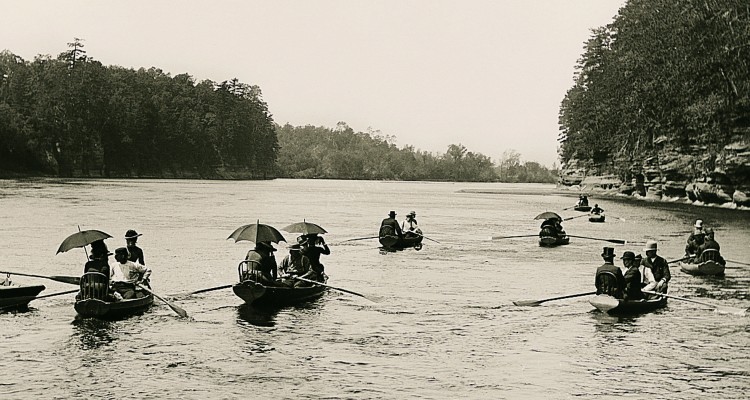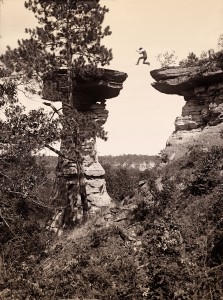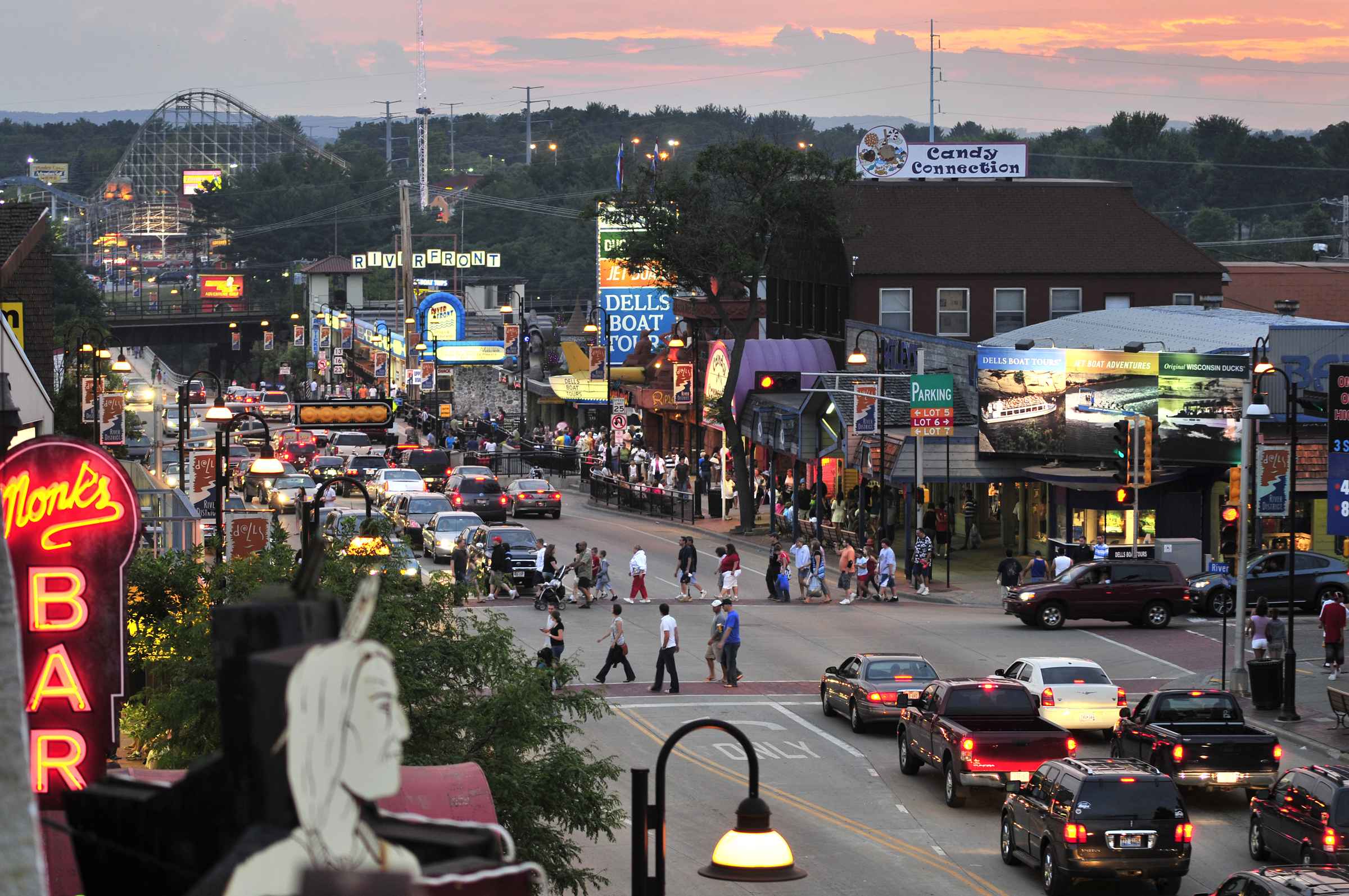
The Formation | The Draw | The Shift | The Future
The Draw
Where the Wisconsin River narrows, just around the bend from the Devil’s Elbow on the north end of the Dells, brown water laps up against the layers of tan sandstone that form the river’s panoramic shoreline. A few feet above, there’s a weathered inscription carved into the side of a towering sandstone rock; words that can only be seen at the right angle and in the right light. They salute a man who first brought visitors to the Wisconsin Dells: “Leroy Gates, Dells and River Pilot, from 1849 to 58.”
Tourism isn’t a new trade for the Dells—it traces back more than 150 years, on the heels of the Romantic period and the Industrial Revolution. The towering cliffs along the Wisconsin River, carved by the draining of Glacial Lake Wisconsin thousands of years ago, home to the Ho-Chunk for hundreds of years and seemingly untouched by capitalism, provided a romantic escape from the city to relish in the sublime and revive the listless spirit.
Just as the story of the Dells began centuries ago, the draw for millions of tourists to this once-untouched land began with the water.
In the 1850s Gates established the first boat tours on the Wisconsin River. In Chicago newspapers, he ran an advertisement promising, “For Recreation, Resort to the Dells! Where depressed spirits can be alleviated, gloom and melancholy will be dispelled, and the mind greatly invigorated.”
Visitors arrived at Gates’ dock along the upper portion of the Wisconsin River eager to see what the Dells had to offer. For a couple of pennies, he gave them two oars. While they rowed up the river, Gates perched under an umbrella and pointed out the sights.
From those simple beginnings, the Dells soon became one of the first resort areas in Wisconsin. In 1855, as frontier settlements were developing rapidly in the area, the Ho-Chunk tribe was being forcibly relocated. Kilbourn, the Wisconsin Dells’ name at the time, prospered because of its proximity to the La Crosse and Milwaukee Railroad, which also allowed easy access to the river’s scenery.
“We conclude that the wild, romantic scenery of the Dells will always make them a place for seekers of pleasure,” newspaper editor Alanson Holly wrote in 1856.
Paintings of mountains, rivers and streams of North America in divine light sparked fantasies of pastoral retreats in the minds of city dwellers and drew visitors to Niagara Falls, the Palisades and Hudson River Valley during the mid-19th century.
It wasn’t paintings but the photography of a man named Henry Hamilton Bennett that catapulted the Dells into the national spotlight.

Photo Credit: Wisconsin Dells Visitor and Convention Bureau
He photographed his most famous work, “Leaping the Chasm,” in 1886, showcasing his son Ashley jumping from a high mainland cliff to Stand Rock, a freestanding rock formation a few yards away. Ashley traversed the gap nearly 20 times before his father finally caught the moment, but the photo served to show skeptics the effectiveness of a new instantaneous shutter he had built.
After winning a national photo contest in Chicago, “Leaping the Chasm” was reproduced in magazines all over the country. Along with its popularity, readers were drawn to its striking scenery in the background and began flocking to Wisconsin to see the Dells for themselves.
Rowboats gave way to steamboats, and in the early 1900s, the land’s lush trees were chopped down and sacred rocks dislodged to make way for new resorts popping up along the river’s shoreline, the domestic retreats for splendor-seeking explorers. Forty families ran tours along the river.
In 1927, a Chicago developer named William Newman continued the tradition of water in the Dells. He led the construction of a man-made lake known as Lake Delton and an additional 1,000 acres of resort shoreline.
However, with the growth of development, one man began to fear the demise of the river’s scenic glory that had characterized the Dells for so long.
George Crandall, an environmentalist and owner of Dells Boat Company, put an end to further development when he purchased the land along the river during the Great Depression, with the intention of preserving the land for generations to come. After Crandall’s death in the 1950s, the land was owned by the Wisconsin Alumni Research Foundation and now by the state Department of Natural Resources.
The environment has remained the same, for the most part, and people do still come to the Dells for the scenery, as they did in the 1850s. But in the years since, new attractions have developed beyond the river, and the pleasure seekers Holly once described come for other reasons.

Photo Credit: Wisconsin Dells Visitor and Convention Bureau
Not too far from the river, the landscape along Wisconsin Dells Parkway and Broadway Street developed into expanses of thriving, memorialized and forgotten gimmicks. Neon signs of varying heights littered the roadside, parading a collage of goofy, gaudy and thrilling splendors. Parents crowded their kids into the family station wagon for a “dream vacation in the Dells.”
New “must-see” exhibitions came and went in Wisconsin’s mecca of fun, shifting attractions from the river and lake to Wisconsin Dells Parkway, the city’s main thoroughfare. Xanadu, a futuristic dome-shaped foam house of the 1980s, gained fame and died out in just eight years, while other attractions created long-lasting memories for generations of tourists.
Manufactured attractions aimed to bring the imagination to life. Children flocked to The Storybook Gardens to climb atop statues of their favorite characters: Little Red Riding Hood, Humpty Dumpty and Jack and the Beanstalk.
A curious cabin tucked in the woods near Lake Delton played host to a “natural phenomenon” known as The Wonder Spot, where no one seemed to stand up straight and water flowed in the wrong direction. Built perpendicular on a slope, the spooky cabin’s optical illusions mystified visitors for nearly 55 years.
Meanwhile, the historical amusement park of Fort Dells took inspiration from Disneyland’s “Frontierland” in the late 1950s, boasting a western theme and 335-foot-tall rotating gondola—one of four in the U.S. at the time.
As the Dells evolved through the mid-20th century, visitors came to see the kitschy attractions and simple delights they offered, while pressure to trump each new attraction increased for business owners.
In 1979 everything changed—Noah’s Ark was built, bringing a jungle of plastic animals to the themed resorts. The park would go on to earn the title of the “Nation’s Largest Waterpark” and start a new flood of waterpark development in the area.
Romy Snyder, executive director of the Wisconsin Dells Visitor and Convention Bureau, says the diversity of attractions made the Wisconsin Dells even more popular.
“Certainly, the more you offer a guest to do and the more there is to do in general, the more people will come,” Snyder says. “[Waterparks] really did bring, in a lot of cases, a new customer to the area, as well as more customers.”
However, the Dells’ economy at the time still heavily relied on the summer months for tourism revenue. Harlan Feldt, a boat tour guide and retired science teacher, recalls his first winters in the Dells.
“It used to be a ghost town when I first came here 52 years ago,” he says.
But that changed in 1994, when the owners of The Polynesian Resort & Suites built a roof over their kiddie waterpark as a way to extend their season well beyond summer and protect visitors from unseasonable weather. The Dells found a way to ensure year-round tourism: indoor waterparks.
“It was really a quite innocent — just ‘Let’s put a roof over it,’” Snyder says.
These businesses carved out a new niche, and nothing was the same again.
As the waterpark industry boomed, casualties ensued. Once-beloved attractions struggled to compete with what the exciting and expansive water parks offered. Fort Dells shut down in 1985, followed by The Wonder Spot in 2006 and Storybook Gardens in 2010.
Still, some of the city’s original attractions continue to thrive.

Photo courtesy of The Tommy Bartlett Show
During the summer months, Tom Diehl, president, general manager and co-owner of the Tommy Bartlett Show, goes to work at 6 a.m. to prepare for the two performances the company puts on each day on the shores of Lake Delton.
Water skiers glide past intrigued audiences, flipping off jumps and forming 12-person pyramids, and performers swirl in circles through the air on hydroflight water rockets, dipping and diving into Lake Delton as water blasts from a hose attached to their feet.
The Tommy Bartlett Show became a novelty on Lake Delton during the 1950s, and further shifted development to Wisconsin Dells Parkway. The show revolves around water, featuring water ski stunts and a variety show, but Diehl says the business has evolved to meet the vacationing consumer’s needs since he started working there in 1967.
“The tourism economy here is a constantly evolving model,” Diehl says. “Nothing stays the same. We’ve adapted very well to that mix.”
During the winter months Diehl and his team work tirelessly to produce a new show for the following summer, choosing new themes, designing costumes and choreographing routines. Diehl continually embraces new technologies, including water launchers in recent years, to keep performances fresh and visitors flowing in.
“It has put a certain demand on the older, mature attractions,” Diehl says. “The waterpark hotels are a tremendous addition to this area, but their customers have a higher propensity to stay in and indulge in the activities that the resorts have.”
For this reason, the Tommy Bartlett Show has also established cross-promotional campaigns with resorts like the Wilderness Hotel and Golf Resort that include admissions deals (“Play Like a Kid, Pay Like a Kid”) and transportation to Lake Delton.
The Original Wisconsin Ducks tour the Lower Dells from April to November each year. Assistant Manager Matt Oeftger talks about this classic attraction’s relationship with the landscape and how the company stays afloat in the Waterpark Capital of the World.
Past the Narrows on the river, algae collects in the stagnant water at Witches’ Gulch, where a wooden boardwalk snakes through a slim canyon of piled rock, leading to a concession stand at the end. The trees, mosses, ferns, lichens and liverworts growing atop of the converging rocks obstruct the sunlight, chilling the temperature of the area. Plastic skulls and an abandoned row boat float in the green, rippleless water, ready for the next round of visitors to arrive on the Ghost Boat tour.
The tour companies that once competed for passengers along the river have been consolidated into the Dells Boat Tours, which leads excursions on the Upper and Lower Dells, including the Original Duck Tours, Jet Boat Adventures and the Ghost Boat Tours.
The Wisconsin Dells continue to draw visitors as attractions evolve and accumulate. While resorts like the Kalahari, Polynesian and Chula Vista stir images of far-off places of beauty and adventure, such scenic majesty can be found a little closer to home.
Today, a flight of stairs descends down the cliffs from Broadway Street to the Dells Boat Tour dock at the river’s edge. Visitors still meet here to relish in the majesty of the bluffs, but the two-story steel boats are a bit more accommodating than Gates’ first operation.
Feldt recalls a time before waterparks surfaced in the 1980s, when there was less competition for tourists’ time and dollars; when the river was still the draw, and boat tours, Native American ceremonies and water ski shows were the supreme attractions.
“They were lined up that stairwell all day long; they were waiting to get on a boat all day long,” Feldt says. “Now, seldom do we have a line of that nature.”

